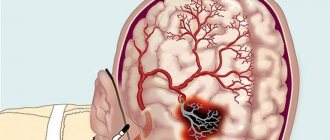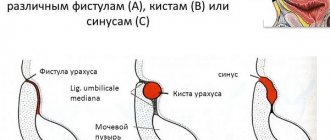- General characteristics Definition of hypoxia
- Development of hypoxia
- Exogenous hypoxia
Hypoxia is a pathological condition in which oxygen deficiency occurs in the body due to its reduced supply from the outside and/or due to dysfunctional utilization in cells.
hypoxia
“Hypoxia” – hypo and oxigenium (lack of oxygen), translation from ancient Greek. Most people understand hypoxia as oxygen starvation (lack of oxygen) , because... in this case, tissues and organs experience dysfunction from oxygen deficiency.
What does fetal hypoxia mean?
Fetal hypoxia is oxygen starvation of the baby in the womb, which occurs against the background of insufficient oxygen supply through the placenta or due to its incomplete absorption by the child’s body. This can happen for various reasons and lead to various consequences.
With hypoxia, the baby does not receive enough oxygen in the womb
According to statistics, more than 10% of births are accompanied by fetal hypoxia of varying degrees.
This dangerous condition leads to changes in the baby's metabolism . At the initial stage of hypoxia, the child’s body tries to compensate for the lack of oxygen and speeds up the work of all organs and systems, but at the stage of prolonged, chronic hypoxia , this mechanism ceases to function and the consequences for the baby can be the most disastrous.
A woman may not even suspect that the child is susceptible to oxygen starvation
Treatment of oxygen starvation
In practice, mixed forms of hypoxia usually develop , as a result of which the treatment of oxygen deficiency in all cases should be comprehensive, aimed simultaneously at eliminating the causative factor and maintaining an adequate supply of oxygen to the cells of various organs and tissues.
To maintain a normal level of oxygen supply to cells in any type of hypoxia, hyperbaric oxygenation (HBO) - barotherapy - is used. In barotherapy, pressure chambers are used in which a person is under increased pressure with a high oxygen content. Due to the increased pressure, oxygen is additionally dissolved directly in the blood plasma, without contacting red blood cells, which allows its delivery to organs and tissues in the required quantity, regardless of the activity and functional usefulness of hemoglobin. Thanks to hyperbaric oxygenation, it is possible not only to supply organs with oxygen, but also to dilate the blood vessels of the brain and heart, so that the latter can work at full capacity.
In addition to hyperbaric oxygenation, cardiac drugs and drugs that increase blood pressure are used for circulatory hypoxia. If necessary, a blood transfusion is performed (if blood loss incompatible with life has occurred).
For hemic hypoxia, in addition to hyperbaric oxygenation, the following therapeutic measures are carried out:
- Blood or red blood cell transfusion;
- Introduction of oxygen carriers (Perftoran, etc.);
- Hemosorption and plasmapheresis to remove toxic metabolic products from the blood;
- Introduction of substances capable of performing the functions of enzymes of the respiratory chain (vitamin C, methylene blue, etc.);
- Introduction of glucose as the main substance that provides cells with energy to carry out vital processes;
- Administration of steroid hormones to eliminate severe oxygen starvation of tissues.
Signs of fetal hypoxia during pregnancy
In the early lines, it is extremely difficult to assume fetal hypoxia. This can only be evidenced by the presence of certain diseases in the mother , which a priori pose a threat to the oxygen supply to the fetus. Such diseases include:
- anemia (low hemoglobin content in the blood of a pregnant woman)
- lung diseases (asthma, bronchitis)
- diabetes
- cardiovascular diseases
- some kidney diseases
- intoxication
- oncology
- alcoholism and drug addiction
Smoking is one of the factors that provoke fetal hypoxia.
It is possible to assume that perhaps the baby in the womb is exposed to oxygen starvation using ultrasound . If the child’s parameters do not correspond to the deadline, namely, they are less than normal, then this indicates a lack of nutrients or oxygen .
Also, a Doppler study during hypoxia will show a rapid heartbeat or, conversely, a slow heartbeat.
Doppler measurements can reveal circulatory disorders in the arteries and placenta, which clearly leads to fetal hypoxia.
Ultrasound with Doppler
In the second half of pregnancy, when the baby in the womb pleases the mother with movements , the pregnant woman herself can establish hypoxia.
If the baby is too active or his movements occur less frequently than usual, then the woman should consult a gynecologist, because changes in the rhythm of the baby’s movements are one of the most obvious signs of hypoxia.
Prevention
In order to prevent fetal hypoxia, the expectant mother is recommended to lead a healthy lifestyle. A pregnant woman should avoid smoking and alcohol, emotional stress and heavy physical labor. Her diet should include a variety of healthy foods, enriched with all vitamins and minerals.
The basis for preventing oxygen starvation of the fetus is pregnancy planning. Before conceiving, the expectant mother is recommended to compensate for all chronic pathologies, to be checked for sexually transmitted diseases in order to exclude and not know what hypoxia is in the child.
What causes fetal hypoxia during pregnancy?
As mentioned above, insufficient oxygen supply from mother to child can be caused by various diseases of the woman.
But this is not the only factor causing hypoxia. It has been scientifically established that smoking by a woman who is carrying a child can provoke a lack of placental nutrition, which means that the child in this case will receive less oxygen.
Smoking during pregnancy is a path to childhood disability
Rare exposure to fresh air also has a negative impact on the condition of the woman and child . If a woman stays in a stuffy room for a long time, this can also lead to fetal hypoxia.
a pregnant woman should spend as much time as possible outdoors
But not only changes in the mother’s body can provoke a change in the volume of oxygen that reaches the child. The following causes of fetal hypoxia are also identified , associated with changes in the child’s body and the characteristics of pregnancy:
- placental lamination
- gestosis
- congenital malformations of the fetus
- post-term pregnancy
- infection
- anemia in a child
- umbilical cord entanglement
Hypoxia of the child during childbirth
Acute hypoxia can also occur during childbirth if the labor of the woman in labor is weak and the child remains in the birth canal for a long time.
Causes
There are many reasons that cause intrauterine fetal hypoxia. The most common of them include the following factors:
Gestational hypertension (late gestosis)
This pathology occurs due to improper development of the uteroplacental vessels after 20-22 weeks of pregnancy. To restore blood flow, a woman’s body reflexively increases blood pressure. For some time, this measure is effective.
However, with an increase in blood pressure, spasm of the blood vessels of the uterus and placenta is observed. A decrease in the diameter of the arteries leads to a decrease in blood flow in them and to chronic fetal hypoxia.
Signs of fetal hypoxia in the third trimester include increased blood pressure, swelling and the appearance of protein in the urine. Typically, the first signs of arterial hypertension appear after 32 weeks of gestation. An earlier onset of clinical manifestations indicates a severe course of the pathology.
Premature abruption of a normally located placenta
Premature placental abruption most often occurs during childbirth, but it can occur throughout pregnancy. This pathology is the most common cause of acute fetal hypoxia.
The pathogenesis of placental abruption is associated with its improper attachment, structural abnormalities, and increased emotional or physical stress. Sometimes this disorder occurs due to a lack of progesterone. Detachment of more than half the area of the placenta leads to immediate fetal death.
Symptoms of premature placental abruption are uterine bleeding and cramping pain in the lower abdomen. If these signs are present, the expectant mother should immediately seek medical help.
Anemia
Anemia is a lack of hemoglobin per unit of blood. Most often, expectant mothers are prone to developing the iron deficiency type of this pathology. Less commonly, anemia occurs due to a lack of vitamin B12, folic acid, bleeding or a disease accompanied by the breakdown of red blood cells (malaria).
The main consequence of anemia is chronic fetal hypoxia. The main symptoms of maternal pathology include dizziness, nausea, weakness, pale skin, and fainting.
Read more: [Causes of anemia during pregnancy]
Infectious diseases
Viral and bacterial diseases are a risk factor for intrauterine fetal hypoxia. Some infections affect the homeostasis system, causing pathologies of the blood coagulation system. Diseases contribute to the formation of microthrombi that clog the lumen of the uterine and placental vessels.
Also, the infectious disease itself can cause a state of intoxication, which contributes to a decrease in oxygen in the blood. Prolonged high fever causes fetal hypoxia.
Multiple pregnancy
When carrying twins or triplets, the likelihood of intrauterine fetal hypoxia increases significantly. This feature is associated with an increase in oxygen demand due to distribution between several fruits.
In rare cases, due to an anomaly of the umbilical cord vessels, a situation arises in which one of the fetuses becomes a “donor” and the second a “parasite”. Due to this, the first child suffers from a lack of nutrients, including oxygen.
Fetal movements / when should you worry?
Diagnosis of fetal hypoxia
- One of the methods for diagnosing the development of hypoxia is listening to the child’s heartbeat using a stethoscope.
- This is done both during a planned visit to the gynecologist, and during labor and childbirth, when there is a high risk of asphyxia of the baby
- But this method is quite inaccurate, since the count of the number of heartbeats may be incorrect, which can lead to an erroneous assessment of the child's condition
Listening to the heartbeat with a stethoscope
- A research method called CTG (cardiotocography)
- The method consists of listening to the fetal heartbeat using sensors, and the result is immediately recorded on paper by the device.
- Having examined the increase or decrease in heartbeat , the doctor makes a conclusion about the condition of the child in the womb
Ultrasound during pregnancy
In case of chronic hypoxia, the size of the baby will not correspond to the gestational age , which can be easily determined using ultrasound .
Hypoxia caused by insufficient placental nutrition can be easily determined using Doppler ultrasound , which will show the condition of the blood vessels and the degree of maturity of the placenta.
There are also various biochemical methods for diagnosing fetal hypoxia, which involve testing the mother’s blood.
Degrees of fetal and newborn hypoxia
Modern medicine distinguishes three types of fetal hypoxia:
- Intrauterine , when the baby suffers from a lack of oxygen while in the womb 2. Intranatal - hypoxia, which develops during childbirth, during the passage of the child through the birth canal 3. Hypoxia of the newborn or asphyxia - oxygen deficiency in a child who has already been born
Hypoxia can also develop after the birth of the baby.
Based on the duration of the period during which the child suffers without oxygen or with little oxygen supply, a distinction is made between chronic hypoxia, which can last several days, weeks and months, and acute hypoxia , which occurs over several minutes and hours.
In its severity, hypoxia can be moderate or severe. This indicator is assessed after delivery using a special Apgar scale . It identifies five main indicators and evaluates them from 0 to 2 points .
Immediately after birth, a general assessment of the newborn's condition is made, and five minutes later a re-assessment is made. If the score is 8-10 points , then the child is healthy and hypoxia did not occur during childbirth.
Apgar score
If the child is given a score of 4 to 7 , then this indicates moderate hypoxia, and with a score of 0-3 points, a diagnosis of severe hypoxia and asphyxia is made.
Consequences
Acute fetal hypoxia is a risk factor for intrauterine fetal death. A chronic type of oxygen deficiency can cause various consequences. The most common consequences of severe hypoxia in newborns are the delay in their growth and development. The likelihood of congenital pathologies of the central nervous system also increases. Cells of the brain and spinal cord are most sensitive to oxygen deficiency.
Hypoxia in newborns, symptoms, consequences and treatment are individual for each child. Children may be different from their peers. This pathology causes mental and mental retardation and brain diseases. Quite often, after birth, such children have a restless character and are difficult to train in the future.
How to avoid fetal hypoxia?
There are factors beyond a woman’s control and hypoxia can develop through no fault of hers. Nevertheless, a woman expecting a child should do everything to ensure that the baby under her heart is comfortable and grows and develops properly.
Smoking during pregnancy is unacceptable - you have no right to harm the health of the child in the womb!
Expert advice will help with this:
- When registering, do not hide the illnesses you have from your
- give up bad habits
- spend more time in the fresh air , walk more
- try to make your diet as healthy and varied as possible, especially for iron-containing foods such as apples, liver, beef, buckwheat, greens, spinach, sea fish, legumes.
- regularly attend consultations with a gynecologist managing your pregnancy, complete the necessary tests and studies on time
- more rest, avoid stressful situations
Products high in iron
Carefully monitor your condition and the condition of your baby. If his physical activity seems strange to you or you experience dizziness, the stomach often becomes hard, then you should immediately consult a doctor, because it is at these moments that the baby may suffer from a lack of oxygen.
What can be the complications of fetal hypoxia?
Unfortunately, hypoxia has serious consequences , which sometimes leave their mark on the child’s entire future life, and sometimes lead to death.
Oxygen starvation at the cellular level is fraught with a lack of energy in the cells and their further necrosis.
The consequences of hypoxia can be fatal
The brain suffers the most when there is a lack of oxygen . Even minor hypoxia can lead to the death of some brain cells, which will certainly affect the child’s health.
But this is not the only organ suffering from a lack of oxygen. Depending on the severity of hypoxia and the duration of this dangerous condition, the following are its consequences in newborns:
- disruption of the functioning of individual organs and their systems, in particular the central nervous system
- high intracranial pressure
- blood clots, tissue hemorrhages
- bradycardia or arrhythmia (fast or slow heartbeat)
- decreased muscle tone
- convulsions
In children exposed to hypoxia, muscle tone is reduced.
One of the most severe consequences of hypoxia is cerebral palsy (CP) , which leads to childhood disability, mental retardation, and a low likelihood of adaptation in society. Among the serious diseases that are provoked by hypoxia are:
- perinatal encephalopathy
- cerebral edema
- hydrocephalus
- epilepsy
- malformations of the heart, kidneys, liver
- cerebral hemorrhage
The brain suffers most from hypoxia
The most serious consequence of hypoxia is death, which occurs due to asphyxia.
Features of the course of brain hypoxia and adaptive reactions of the body
The severity of hypoxia in different organs and tissues may vary. So, if a threatening situation arises, the body will independently redistribute blood in such a way that the brain is supplied with it better than other organs and tissues. This process is called centralization of blood circulation. It can turn on, for example, during acute blood loss.
The result of this mechanism is that the brain suffers less from hypoxia than peripheral organs, such as the liver or kidneys, where irreversible changes do not develop at such a high rate.
What to do if fetal hypoxia is detected?
If you suspect that the baby in the womb is experiencing a lack of oxygen, you should immediately consult a doctor .
He will listen to the fetal heartbeat and, if necessary, refer for additional studies and tests.
Hypoxia is not a death sentence; you need to fight for your baby’s health
Confirming a diagnosis is not a reason to panic . You need to gain patience and follow all the doctor’s instructions in order to help your baby as quickly as possible and save him from serious consequences.
Treatment of fetal hypoxia during pregnancy
Since hypoxia is only a consequence of a disease, to eliminate it it is necessary to cure the underlying disease .
Each organism is individual and there is no general treatment plan for the causes of hypoxia, but thanks to certain measures aimed at stabilizing the condition of the mother and child, hypoxia can be eliminated.
The doctor will prescribe a comprehensive treatment
In case of hypoxia the following is carried out:
- improving placental blood supply with medications
- reducing uterine tone (for this purpose, no-spa, papaverine, drotaverine, Magne-B6 are usually prescribed)
- taking vitamin complexes
- changing your daily routine (increasing time spent outdoors, changing your diet, getting proper rest)
In case of chronic hypoxia, the woman is hospitalized in a hospital , where she is under the supervision of doctors. If the cause of hypoxia cannot be eliminated and the woman’s condition does not improve, then she may be indicated for delivery by cesarean section , which is performed no earlier than the 28th week of pregnancy.
Forecast
The prognosis depends on how severely the child’s brain is damaged. The speed and completeness of medical care is of no small importance. Most babies one month of age and older experience various disorders. They manifest themselves in the form of seizures, hyperexcitability, and perinatal encephalopathy. With high-quality rehabilitation by early preschool age, these phenomena can be eliminated. Although mental lability, headaches and some developmental delays may persist throughout life.
Severe hypoxia can lead to the formation of cysts in the brain, the development of epilepsy, and hydrocephalus. The prognosis depends on the specific complication that occurs in the child.
Every expectant mother should understand the danger of hypoxia for the baby and make efforts to prevent it.
Fetal hypoxia during pregnancy: reviews
Most women who have experienced fetal hypoxia say that this dangerous condition was detected during tests and ultrasound .
Since not all women know about the norms of fetal movement, it is very difficult for many to independently determine hypoxia based on the baby’s activity.
Observe your baby's motor activity
- If hypoxia is suspected or your health worsens, you should contact a gynecologist.
- It’s better to seem like a compassionate mom who worries about anything than to write off your suspicions as deceptive sensations
- So you may miss the development of a condition in which every moment for the baby in the womb turns into suffering from lack of oxygen









